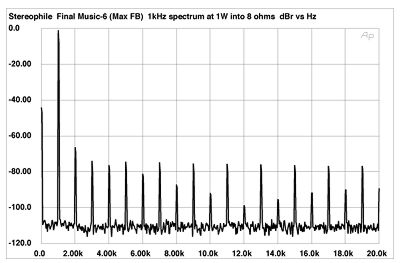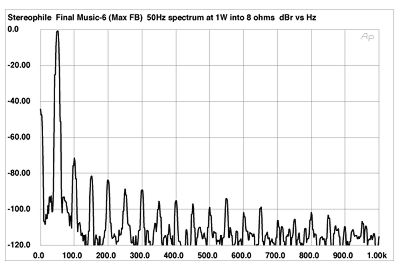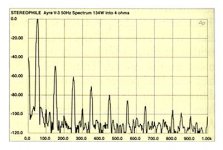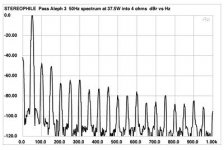johnferrier said:
Ok. Ya built one yet?
JF
No.
The problem is the analog division and analog multiplication of the signals and both sides have to be very equal and division through zero occurs with use of + and - rails
Hurrah!Now this is seminal, we have rarely agreed.... Break out the champers!

Hi Pavel[exp]2,
But I can't agree with either of you!! My case rests!!
Perhaps we should lighten up, say something from left field?
ZERO GLOBAL FEEDBACK DESIGN IDEA
1. SET 845 with grounded grid, 8K OPT, 1000V
2. P type 400V 2A mosfet, source to cathode, drain to ground
3. 150K bias resistor from Gate to bias voltage generator
4. Cascaded 6SL7, 6SN7 both resistively loaded, N7 anode follower to decrease Zout and reduce overall gain to around 200.
This appeals because grounded grid enables superior drive via the cathode, and the power injected at cathode appears at the plate; good feature for SET where power is limited and even small A2 drive completely throws conventional grid drive.
The mosfet can be driven via a CFP, using a bipolar transistor.
Cheers,
Hugh
But I can't agree with either of you!! My case rests!!

Perhaps we should lighten up, say something from left field?
ZERO GLOBAL FEEDBACK DESIGN IDEA
1. SET 845 with grounded grid, 8K OPT, 1000V
2. P type 400V 2A mosfet, source to cathode, drain to ground
3. 150K bias resistor from Gate to bias voltage generator
4. Cascaded 6SL7, 6SN7 both resistively loaded, N7 anode follower to decrease Zout and reduce overall gain to around 200.
This appeals because grounded grid enables superior drive via the cathode, and the power injected at cathode appears at the plate; good feature for SET where power is limited and even small A2 drive completely throws conventional grid drive.
The mosfet can be driven via a CFP, using a bipolar transistor.
Cheers,
Hugh
Hugh,
great idea. But I am sad that you have not noticed the circuit that I shown in post #276.
Cheers,
Pavel
great idea. But I am sad that you have not noticed the circuit that I shown in post #276.
Cheers,
Pavel
Pavel,
I have just re-examined your seminal design.
No one has done a plate loaded transistor before; I am most impressed! This draws on simple cascade, tube circuitry, and adds the brilliant concepts of zero fb SS. 'Tube grace, SS muscle'.
I like it a lot! The way you have cut through all this absurd biasing complexity, and incorporated base stoppers together with level shifting; this is a work of genius, Pavel, and I feel you should be nominated for the Nobel for this.
The way in which you avoid any possibility of rail latching is also very appealing. This circuit would be extremely stable; in fact, it would effectively be monostable!!
I might suggest this is the electronic equivalent of the Hoffnung Music Festival........
Who was that marvellous Czech author, Milan Kundera, who wrote "The Incredible Lightness of Being"? Post #276 is in the same spirit, Pavel, my congratulations. It is at once parody and art form - something I would expect from the subtle Czech mind...
At present I am working on my upgrade package for the AKSA amplifiers, and wrestling with sibilance, the scourge of feedback amplifiers!
Cheers,
Hugh
I have just re-examined your seminal design.
No one has done a plate loaded transistor before; I am most impressed! This draws on simple cascade, tube circuitry, and adds the brilliant concepts of zero fb SS. 'Tube grace, SS muscle'.
I like it a lot! The way you have cut through all this absurd biasing complexity, and incorporated base stoppers together with level shifting; this is a work of genius, Pavel, and I feel you should be nominated for the Nobel for this.
The way in which you avoid any possibility of rail latching is also very appealing. This circuit would be extremely stable; in fact, it would effectively be monostable!!
I might suggest this is the electronic equivalent of the Hoffnung Music Festival........
Who was that marvellous Czech author, Milan Kundera, who wrote "The Incredible Lightness of Being"? Post #276 is in the same spirit, Pavel, my congratulations. It is at once parody and art form - something I would expect from the subtle Czech mind...
At present I am working on my upgrade package for the AKSA amplifiers, and wrestling with sibilance, the scourge of feedback amplifiers!
Cheers,
Hugh
Hugh,
I wish I was able to express myself in English in such a brilliant way! 😉 😉
Cheers,
Pavel
I wish I was able to express myself in English in such a brilliant way! 😉 😉
Cheers,
Pavel
AKSA said:Terry,
Thanks for your post. I believe I've met Astley; he has a repair business, I believe? If it's the same man I sold him a couple of GM70s about five years ago; he drove them in grounded grid. I spoke with him, and he seemed extraordinarily aloof about his designs (perhaps he is me in a parallel universe??).
In any event, I'm fascinated to hear you mention him.
Hugh
Aaaaaahhhh, just got back from a wickedly tough MTB ride and
am enjoying a beer to cool down... life is good 🙂
Where were we...
Astley is quite a different kind of guy, and when I first
spoke to him on the phone, I thought "hmmmmmm" 🙁
However, I cut him some slack and as with most people,
he is a really great guy when you know him. 🙂
He is definately one of the few designers that comes up with
novel and new concepts, so that is probably the reason for
being aloof.
His latest design is an OTL, which is apparently some part
of a circlotron but not fully balanced, he calles it a "semi-circlotron"
Got a good sense of humor that lad 😉
Cheers
T
While searching the web for something unrelated, I happened across this page, which I think amply proves that followers are every bit as much feedback amplifiers as opamps.
http://digilander.libero.it/paeng/cathode_follower_follows__audio.htm
se
http://digilander.libero.it/paeng/cathode_follower_follows__audio.htm
se
PMA said:This is funny, as all of those much loved zero feedbacks, simple the bests etc. have not only 2nd a 3rd harmonics, but the full row of them like mountains and ridges. Look at Ayre-V3, measurement by Stereophile, typical example:
What 2nd? The 2nd's way down about -95dB. All those big spikes are the odd-ordered harmonics.
se
PMA said:And this is Pass Aleph3. Remarkable, indeed. Not only odd, but also even harmonics, just like a harmonic synthesizer (the true "harmonic fullness"):
Well, let's be fair and toss in at least one amp with lots of feedback. Wanna see something reeeeeally scary?

That's the Final Labs Music 6 set to maximum feedback. It's based on a power opamp so there's quite a lot of it.
Oops. That's at 1kHz. Here's the 50Hz plot:

Wonder why JA seems to randomly choose 50Hz and 1kHz when he tests amps? Some amps he'll use both 50Hz and 1kHz, others it'll just be 50Hz and others still will be just 1kHz.
se
Completely agree. This is a question of a circuit design. But can you show me the so called "non-feedback" amp with low level of distortion or with the only low-order harmonics above -100dB.
This is absurd! They are all terrible! Even NP's stuff which sounds wonderful!
Anything beyond H4 (OK, maybe H5) is clearly discordant, too.
And now the $64K question:
1. ARE WE MEASURING THE WRONG THING?
2. IS HARMONIC SPECTRUM RELEVANT AT THESE LEVELS?
3. ARE WE IMAGINING DIFFERENCES WHERE NONE EXIST?
4. ARE SONIC DIFFERENCES ATTRIBUTED TO SOMETHING COMPLETELY DIFFERENT WE HAVEN'T THOUGHT OF YET?
In true Australian, 'Are we just a bunch of tossers?'
Cheers,
Hugh
Anything beyond H4 (OK, maybe H5) is clearly discordant, too.
And now the $64K question:
1. ARE WE MEASURING THE WRONG THING?
2. IS HARMONIC SPECTRUM RELEVANT AT THESE LEVELS?
3. ARE WE IMAGINING DIFFERENCES WHERE NONE EXIST?
4. ARE SONIC DIFFERENCES ATTRIBUTED TO SOMETHING COMPLETELY DIFFERENT WE HAVEN'T THOUGHT OF YET?
In true Australian, 'Are we just a bunch of tossers?'
Cheers,
Hugh
I can say that they (Stereophile) do not measure wrong (i.e. this is not an error of the measurement). We have also compared different amps (including A3) with similar results. And also measured perfect results on another topologies.
Hugh, you probably know well the measurements shown on my web site. We have recently compared our measuring method with AP, and got the results that differ only by 0-4dB down to -120dB levels.
Cheers,
Pavel
Hugh, you probably know well the measurements shown on my web site. We have recently compared our measuring method with AP, and got the results that differ only by 0-4dB down to -120dB levels.
Cheers,
Pavel
SPL!!!!!
Folks,
You must compare plots of equal output.
The first graph are 134W, the last one 1W. Big wonder, there's a difference.
(I would prefer to see graphs for 10W and 0.1W, BTW)
Regards,
Peter Jacobi
Folks,
You must compare plots of equal output.
The first graph are 134W, the last one 1W. Big wonder, there's a difference.
(I would prefer to see graphs for 10W and 0.1W, BTW)
Regards,
Peter Jacobi
Peter, they would never do, because the Aleph would win at 0,1W. Would be bad for the high feedback, class AB industrie...
till said:Peter, they would never do, because the Aleph would win at 0,1W. Would be bad for the high feedback, class AB industrie...
The trust is mighty. Feedback closed around linear stages (not swictching) gives again results never reached by A3.
- Status
- Not open for further replies.
- Home
- Amplifiers
- Solid State
- Feedback artifacts, cars and semantics

